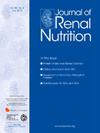生物阻抗光谱仪和计算机断层扫描得出的慢性肾病患者的去脂质量非常吻合。
IF 3.2
3区 医学
Q2 NUTRITION & DIETETICS
引用次数: 0
摘要
目的:营养不良在肾衰竭患者中非常普遍。由于体重并不能反映身体成分,因此需要其他方法来确定肌肉质量,通常是通过去脂质量(FFM)来估算。生物阻抗光谱法(BIS)常用于监测肾衰竭患者的身体成分。遗憾的是,BIS 得出的瘦组织质量(LTMBIS)不适合与 FFM 临界值进行比较,以诊断营养不良或计算膳食蛋白质需求量。假设可以从 BIS 数据得出 FFM(FFMBIS)。本研究旨在将 FFMBIS 和 LTMBIS 与计算机断层扫描(CT)得出的 FFM(FFMCT)进行比较。其次,我们还旨在探讨使用不同方法对计算出的蛋白质需求量的影响:对 60 名 CKD 4-5 期患者的 L3 层肌肉横截面积进行了 CT 扫描分析,并将其转换为 FFMCT。通过计算斯皮尔曼等级相关系数和 95% 的一致性限值 (LoA),将 FFMBIS 和 LTMBIS 与 FFMCT 进行比较。根据 FFMCT、FFMBIS 和调整后体重确定膳食蛋白质需求量。偏差超过10%被认为与临床相关:FFMCT 与 FFMBIS 的相关性最强(r=0.78,pBIS 与 FFMCT 的相关性(LoA:-14.88 至 13.7 千克,p=0.544)。LTMBIS 和 FFMCT 之间的平均差异为-12.2 千克(LoA:-28.7 至 4.2 千克,以 pCT 为参考,FFMBIS 预测蛋白质需求量最佳)。根据 FFMBIS 和 FFMCT 预测的蛋白质需求量的平均差异为:男性 -0.7 ± 9.9 克,女性 -0.9 ± 10.9 克:结论:在群体水平上,FFMBIS与FFMCT具有良好的相关性,但在个体内部仍存在较大差异。正如预期的那样,在计算出的蛋白质需求量中观察到了与临床相关的巨大差异。本文章由计算机程序翻译,如有差异,请以英文原文为准。
Fat-Free Mass Derived From Bioimpedance Spectroscopy and Computed Tomography are in Good Agreement in Patients With Chronic Kidney Disease
Objective
Malnutrition is highly prevalent in patients with kidney failure. Since body weight does not reflect body composition, other methods are needed to determine muscle mass, often estimated by fat-free mass (FFM). Bioimpedance spectroscopy (BIS) is frequently used for monitoring body composition in patients with kidney failure. Unfortunately, BIS-derived lean tissue mass (LTMBIS) is not suitable for comparison with FFM cutoff values for the diagnosis of malnutrition, or for calculating dietary protein requirements. Hypothetically, FFM could be derived from BIS (FFMBIS). This study aims to compare FFMBIS and LTMBIS with computed tomography (CT) derived FFM (FFMCT). Secondarily, we aimed to explore the impact of different methods on calculated protein requirements.
Methods
CT scans of 60 patients with kidney failure stages 4-5 were analyzed at the L3 level for muscle cross-sectional area, which was converted to FFMCT. Spearman rank correlation coefficient and 95% limits of agreement were calculated to compare FFMBIS and LTMBIS with FFMCT. Protein requirements were determined based on FFMCT, FFMBIS, and adjusted body weight. Deviations over 10% were considered clinically relevant.
Results
FFMCT correlated most strongly with FFMBIS (r = 0.78, P < .001), in males (r = 0.72, P < .001) and in females (r = 0.60, P < .001). A mean difference of −0.54 kg was found between FFMBIS and FFMCT (limits of agreement: −14.88 to 13.7 kg, P = .544). Between LTMBIS and FFMCT a mean difference of −12.2 kg was apparent (limits of agreement: −28.7 to 4.2 kg, P < .001). Using FFMCT as a reference, FFMBIS best predicted protein requirements. The mean difference between protein requirements according to FFMBIS and FFMCT was −0.7 ± 9.9 g in males and −0.9 ± 10.9 g in females.
Conclusion
FFMBIS correlates well with FFMCT at a group level, but shows large variation within individuals. As expected, large clinically relevant differences were observed in calculated protein requirements.
求助全文
通过发布文献求助,成功后即可免费获取论文全文。
去求助
来源期刊

Journal of Renal Nutrition
医学-泌尿学与肾脏学
CiteScore
5.70
自引率
12.50%
发文量
146
审稿时长
6.7 weeks
期刊介绍:
The Journal of Renal Nutrition is devoted exclusively to renal nutrition science and renal dietetics. Its content is appropriate for nutritionists, physicians and researchers working in nephrology. Each issue contains a state-of-the-art review, original research, articles on the clinical management and education of patients, a current literature review, and nutritional analysis of food products that have clinical relevance.
 求助内容:
求助内容: 应助结果提醒方式:
应助结果提醒方式:


